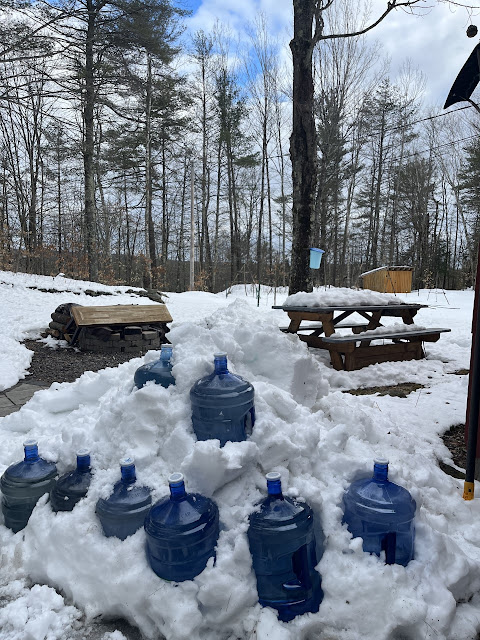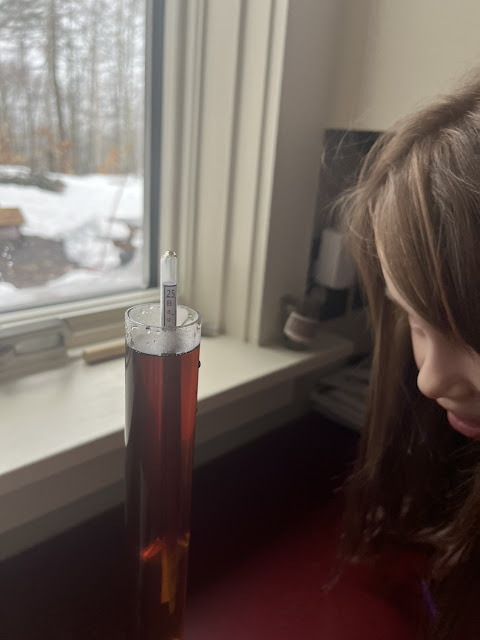Spring has sprung and this past week found the homestead stirring with activity as we finished up the last drips of maple sap, sorted through our seed stocks, inventoried our bee keeping supplies, jumped in head first to learning about mushroom cultures and finished off the week with a little date night... soaking up some culture in our old stomping grounds of Portland.
Ok first lets start with the mushroom project!
As we are just starting to learn the in's and out's of cultivating mushrooms I will not go super in depth on the process as I am still fine tuning my methods. We will surely have some success and failures to share as we navigate through all the information and experiences that come with this unique hobby. I will provide helpful info when I feel its valid, but keep in mind we are newbies and without real time experience under our belt, we currently are just absorbing and regurgitating information at this stage in our fungal explorations.
As some of our longtime visitors may know we have been dabbling in foraging and log grown shiitakes for a few years now but up till now I have always purchased spawn from local mushroom companies to inoculate our logs. Part of my exploration currently is learning how to create our own spawn in order to grow our mushroom knowledge and make cultivating them more affordable. I've had this itching interest since I was about 14years old and probably even before that. The older I grow the more I realize how beneficial they are to our bodies, minds and ecosystem. Recent studies done by John Hopkins along with all the information coming out about the symbiotic relationships that occur in nature with fungus and other organisms simply reinforce these curiosities and inspire me to learn more. Did you know that some trees use the fungal mycelium layers between them to communicate and share nutrients
back and forth through the underlying mycelium network that is vastly operating throughout the worlds forests? What... no really it blows my mind that there is still so much we do not understand about these mycelium networks, similar to space and the deep depths of the ocean.
Here I am pictured at age 16 with my award winning colored pencil drawing of an Aminata Mushroom that appeared behind the basketball hoop in our suburban yard. I remember being so intrigued by it and after spending a few afternoons observing it I decided to devote a couple weeks of painstaking colored pencil work creating this piece that I titled "Ant's View".
So fast forward now to the age of 43 and I have decided to dive even deeper into the world of fungus and harness the knowledge shared by so many Myconauts, Mycologists and just FunGuys over the past few decades of eye opening research :)
Ok so to get started I went through a local mushroom supplier to obtain some liquid cultures to start our culture bank and experiment with sanitizing and dialing in the moisture content of substrates. To get those cultures to grow I decided to start with growing them out in jars of grain. After a 24hr cold soak I rinsed and dried a blend of Maine Grown Wheat and Rye Berries and used the run off liquid to make a agar solution that is then poured into petri dishes as a fertile spot to grow out cultures and screen them for contamination.
Once the grain blend is fully hydrated and then air dried to touch it is transferred into jars.
These jars are your typical canning jars with holes drilled into the lids. Each of the lids gets a filter placed on it with one being a simple vent to allow excess moisture and heat to dissipate from the jar but is a special material that filters any contaminates from entering from the outside atmosphere. The other filter is a self sealing material that allows you to inoculate the grain with a syringe loaded with spores. The grain is essentially the food for the spores to grow on and form a strong network that eventually will be spread onto a larger growing substrate in order to kick start the fruiting stage of the mushroom!
But before inoculation can occur we need to sterilize the grain so that no bacteria from our kitchen or that is naturally present on the grain can contaminate it causing the whole process to veer off course. This is the mycological dance of a mushroom grower. Making a substrate ripe with nutrients and moisture for the spores to flourish and trying not to let it invite any of its nasty bacterial relatives that want to spoil the magic!
So before inoculation we need to sanitize these jars in our autoclave... which was part of my Christmas present this winter! I started small with the All American 1915X Model primarily because we have a glasstop stove so I didn't want to get the heavier larger size and increase the chance of breaking the stovetop which some people have warned could happen when running this equipment on this type of stove. But after checking the weight specs on our stove model it seemed more than reasonable to make it happen and after a couple of runs I don't see having any issues. It will be very helpful to make this process more sanitary and open up the possibilities of summer canning as well! Till now our canning method has always been the hot water bath so I always go a lil heavy on the lemon juice and vinegar to make sure we do not encounter botulism but with an autoclave you open up the world of canning lots of veggies as the pressure and internal temperatures that this tool allows gets you up to a temp that doesn't allow any of those issues to arise... so onward and forward with the canning recipes for 2023!
Here is a sanitized and ready to inoculate jar of grain!
At the moment all the inoculating and open air processes need to be done in as safe an area as possible. Here is the humble beginnings of our mushroom lab. As you can see we are starting pretty lowtech. The upside down storage container with arm holes cut into them are what we call a "Still Air Box" or SAB. This box is meticulously sprayed down with isopropyl alcohol before every step and then everything is also wiped clean before working on it inside the box. We wear gloves that are also slathered with sanitizer to limit any outside contamination... which will inevitably happen but the more meticulous and aware you are the less chance that will happen. Someday I hope to be able to afford a Laminar Flowhood which allows a little more freedom of movement for the workstation but they are expensive so I want to make sure this is something I enjoy doing on a bigger scale before making the investment in that piece of equipment as its only purpose would be for mushroom cultivating unlike the autoclave which also serves as a food preservation tool!
Here is a view through the armholes... I use a clear plexi sheet to cover the holes when I'm not using the box but it still needs a fresh sanitizing anytime you preform any task inside. Here you can see the stacks of petri dishes I have ready to collect culture samples from my current array of spores.
Mushroom Supply Station
Other than the autoclave, most mushroom supplies are very affordable and most stuff I had laying around or easy access to. Jars, Filters, Grain, Hardwood Pellets, Coco Coir, Agar Powder, Gypsum, Nutritional Yeast along with some storage containers, strainers, scales and measuring cups!
Our first inoculations are done! We started with three syringes of liquid culture.
King Trumpet/ Black Pearl King Oysters / Chestnuts
Along with inoculating two jars of each I dribbled a few drops onto the petri dishes of agar to collect a spore sample to grow out into future batches. If all goes well these jars will be full of happy mycelium in the coming month or two and then they will be spread across a larger growing substrate and we will begin our indoor mushroom project in full force!
Our first signs of a successful culture!
And speaking of first signs...always the first to bloom on the homestead every spring are these precious lil dwarf irises. Always a sign of the snow pack receding!
Variety: Katharine Hodgkin Dwarf Iris
(hybrid of the iris winogradowii & iris histrioides)
With all this excitement around the homestead we got a chance for a night out, so Cassi and I made our way into Portland for a date night! We kicked it off with a few delicious cocktails in our old west end neighborhood at a place called the Danforth... which we recalled being a corner store named Vespucci's that had an odd array of pizza sizes that ranged from 6" all the way to a huge 48" size. Nothing fancy but the nostalgia was thick as we talked about the old days of the west end while sipping fancy cocktails and smearing fresh chive butter on a slab of warm sourdough from Zu bakery next door.
From there it was off to the Portland Museum of Art where they had a folk art exhibition that lured us in as well at the free admission on Fridays! I always am drawn to the landscapes of the "folk" artists and was happy to see a couple classic Grandma Moses pieces along with some lesser known but equally inspiring work.
After a long walk around the peninsula we were shut down by couple hour wait times at some of the new to us establishments and started to feel a little desperate and overwhelmed by the "current scene" In a last ditched effort to find a spot we were excited about we hoofed it across the old port to Miyake and we presented with a perfect lil bar nook and ended up being surrounded by a staff of familiar faces and an absolutely awe inspiring meal that checked all the boxes of old classics, new flavors and unique and unfamiliar combinations.
Masa always focused and reserved.
Pictured here is our "Omakase Hassun" with offerings of wasabi dusted flounder, lobster ceviche, a dashi soaked oyster with enoki mushrooms, seared beef over a potato egg salad like concoction and the most interesting yet delicious dish (pictured below) was these baby squid over tuna with a spicy mustard type sauce.
I could eat this and all the other offerings we picked over and over in my head!
The flavors were so focused and balanced and we were also excited to see the addition of some tasty cocktails on their menu! The Nikka Manhattan was a stand out for me personally as well!
Thanks for stopping by the old blog... I'm always encouraged to see the amount of traffic here and am thankful to each and everyone of the over 280,000 views so far!
Feel free to leave a comment, ask a question or let us know what you would like to see more or less of!
Till next time.































